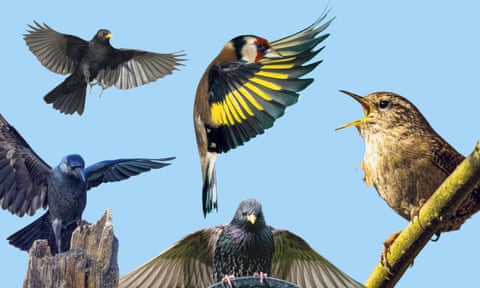It’s six in the morning and still dark, 24 March 2020. I wake early and, knowing the children will soon be up, decide to steal half an hour’s solitude in the park. From the dense latticework of trees and shrubs that clothe the wooded slope comes a constant scuttling through dead leaves. The darkness is awake and vigilant; there’s the warning tik-tik of an invisible robin from the bushes, and then the next second it appears on the path. Each individual movement of the bird, each wing-flick and pivot, is brisk and definite yet the overall impression is one of nervousness and indecision. It leaps round once more on the spot, then flits back into the darkness.
From close by comes a blast of song from a wren. Its harsh trill is like coarse twine zipping over a flywheel. The air is cool, not cold, and smells deliciously of earth and moss. There’s a sudden disturbance from the deeper shade, and a blackbird comes careering out with a mad clatter and pauses, alert, on the great arm of a beech tree. It’s evidently agitated. It flicks about the bough, dipping then raising its wings, and tilting its head all the while in response to something I can’t sense. After a few seconds of this twitching the bird seems to experience some sort of inner resolution, and, as the first beam of grey light wakes the colours of the tree, it raises its head and lets out a quiet phrase of song. Spring has arrived.
The day before my early walk in the park, the prime minister ordered a shutdown of public life that would entirely change society as we’d known it. By government decree, normal life was suspended. In the coastal town where I live, compliance was immediate and total. All traffic noise ceased, and you could hear litter scuffing down the empty streets. It felt as if nine-tenths of the population had disappeared overnight. The strangeness was amplified tenfold by the difficulty of reconciling this “lockdown” with the sudden coming of the most glorious spring that anyone could remember.
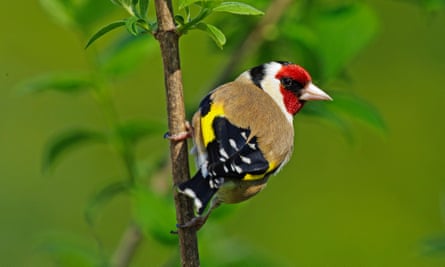
Goldfinch (listen to its song here)
Pert, painted, gorgeous. A slim Fabergé sparrow. Buff and white but face dipped in vermilion, and wings lacquered in gold. Thickset ivory beak for cracking seeds. Flocks in buoyant squalls over teasels, but can turn up anywhere. Creaky notes. Song a geyser of bubbling bells or a flypast of wind chimes.
But most of all, we began to notice the birdsong. A little tentative and sputtering at first, by the end of March it filled the air. Broadcast from aerials and hedge tops, a rising choir of chirps, trills and warbles brought life to gardens and echoed off housefronts and shuttered shops with no traffic noise to smother it.
Some bird calls are present all year around, and these are among the easiest to recognise. Everyone knows the crow’s harsh croak, and the oily yelp of gulls. But with the spring came other songs that were harder to place. As lockdown continued into April, it became clear that thousands of people across the British Isles and beyond were becoming enchanted by birdsong. Beautiful and lilting, or monotone and irritating, we recorded the sounds of thrushes, tits and finches on our phones, and asked one another about them or simply shushed family members and called them over to listen.
The pandemic had struck the northern hemisphere at just that moment in the natural calendar when birdsong resumes in full force after the quiet and solitary winter months. Millions of people were not just hearing but actively listening, perhaps for the first time, to the songs of birds – ancient songs, perhaps unchanged from the stone age.
I started watching birds when I was seven. My parents encouraged it and soon became enthusiasts in their own right. This was in Birmingham, which you mightn’t think an ideal place for birdwatching, but we lived a half-hour’s walk from a nature reserve, and I’d go down there most weekends or after school, with my father or, increasingly, on my own. By my early teens I could identify most British birds by sight and sound, my knowledge growing as we came across different species on trips to the countryside and coast. It probably peaked around the age of 18, but the interest never disappeared altogether. Then suddenly, last spring, out of work and with a bit of time to look and listen, I felt my curiosity about birds reawaken.
In lockdown, on solitary walks, I started paying attention. The trees are renewed, and improbably beautiful. At the bottom of the road a copper beech shelters our local mob of vigilante jackdaws. They’re not bothered by me but tilt their shoehorn heads and make a soft cacophony of caws and sneezes when a raven passes high above.
Over the past 100 years or so, researchers have started to investigate what these sounds actually mean to the birds. Some calls are quite obviously intended to warn of predators, while others relate to rituals of courtship and display. And some may be neither: Charles Darwin suggested that birds are moved by emotions and may sing from “mere happiness”.
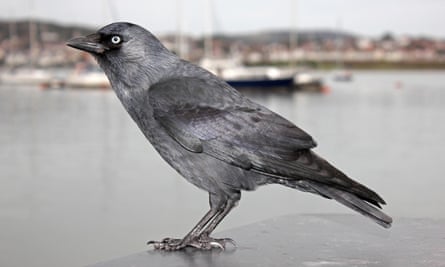
Jackdaw (listen to its song here)
A small crow. Sooty black with silver cape and a smoky opal iris. Socialises in small flocks. Infinitely curious. A municipal inspector of kerbs, with a wide-legged gait, as though its bootlaces had come undone. An arsenal of caws: harsh and affronted to intimate and genial. A delightful, companionable bird.
Recognising the calls and songs of even a few species of birds can enrich one’s understanding of the world by revealing an almost forgotten aspect of the grammar of reality. The calls and responses range across various bandwidths, and some speak to the soul more readily than others. Even in bright June sunshine a robin’s sombre phrase can bring on a reflective mood, and who has not sometimes felt cheered by the daft laughter of park ducks? Some bird calls seem to have the power to short-circuit time and take you straight back to childhood.
Above all the other birdsongs of March, the blackbird’s rises unmistakable – strident and clear. In the sombre spring of last year, when the usual noise of people and cars was absent, the song, transmitted from aerials, trellises and lamp-posts, felt loud and life-affirming, compelling in its variety and the emotion it seems to contain.
While each bird species possesses its own distinctive calls and songs, in the blackbird the variety of sounds is quite astonishing. From close listening I was able to categorise blackbird songs (as opposed to simpler, more standard calls) into four or five basic types – but then the more I listened, the more I became aware of such internal variation in these songs as to almost make a nonsense of trying to fix them in this way. Indeed, it gradually dawned on me that at least some of the birds I regularly heard from the house, in the park and at the garlic wood nearby had their own individual quirks of speech, just as people do.
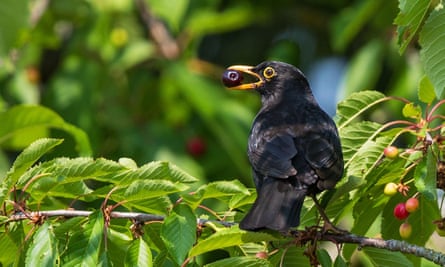
Blackbird (listen to its song here)
Dark of feather and mien. Breeding males black with marigold bill and eye-ring. Females leaf-litter brown with lemony bill and an undercoat of speckles on the belly. Emits tetchy clucks, hysterical rattles and a sinister ventriloquial whistle. Spring song is glorious – rollicking and woozy. Spot them on aerials at dusk.
I often lingered in the wood at twilight, listening to the birds as, one by one, they ceased to call. The wood pigeons were the first to break off, followed by the nuthatches, the woodpeckers and the dunnocks. By seven o’clock the only songs left were the hesitant phrases of the robin, the sharp, rapid spool of the wren, and three or four blackbirds still going strong. It was only after another hour that the last songbird fell silent. Later, back home, I put my head out of the skylight to listen to the cock blackbird on our terrace exchange songs with two others in the nearby park. The most distant of the park birds is a real virtuoso, and he seems to enjoy the contrast between mellifluous, fruity passages and clownish, off-key notes. I call the children to listen, and for a few moments we’re all quiet, our heads protruding from the roof above the quiet streets, attentive to the song that pours out of three minuscule throats.
Transcribing the calls of birds is a hopeless task. I noticed that they don’t seem to use consonants. Vowels seem better equipped to approximate some bird sounds, but here, too, we can only convey a vague similarity. We shouldn’t be surprised: birds have neither lips, nor teeth, nor vocal cords, and though they do have a larynx it is not for them the “voice box” that it is for us. Instead, birds have an organ called a syrinx, named after the nymph of Greek mythology who was transformed into reeds from which the first panpipes were made.
All the species that we call songbirds have their syrinx between the windpipe and the tubes – or bronchi – that lead to the lungs, and are able to produce sound with air drawn from either the left or right lung, or both at once. It’s the ability to switch at great speed between different bronchi that allows for the astonishing sophistication of birdsong. Different notes, pitches and tones can be emitted from each bronchus. Some birds, such as the song thrush, can even overlay a set of notes produced from one side of the syrinx on to a different, lower-pitched set emitted by the other side. It is as though you or I sang melody and harmony at once, drawing from a nearly limitless number of notes, at a rate of up to 40 notes per second. There’s a robin at the end of our street, a streetlamp crooner who only really gets going at dusk. When I first began listening to him I could only distinguish three or four phrases that seemed to be repeated, often in the same sequence, over and over again. Two weeks later, I’d lost count of the subtle variations that leaven his song.
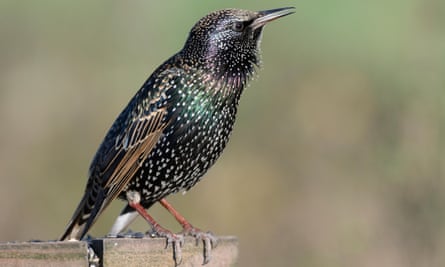
Starling (listen to its song here)
Glossy black at distance; close-up a galaxy of spangles, every colour of the petroleum rainbow. Juveniles ash-brown. Quarrelsome, chatty, gregarious – very seldom seen alone. Walks on lawns, playing fields, car parks. Flies with rapid beats of stiff wings. Very vocal: gobbling chatters, pop-gun detonations and saucy whistles. A lover of innuendo.
Should we think of birds’ sounds as language? Nobody who has watched birds for any time at all could reasonably doubt that they’re communicating with one another. Recently, while I was wondering about this, a large seagull landed on next door’s shed and began making the nervous, rapid ak-ak-ak that meant it had spotted the cat glowering on the opposite wall. No doubt the sound reflected the bird’s own anxiety, but it was also understood by all the other gulls around.
More than that, the basic message of alarm was certainly recognised by other species, too. Sometimes a buzzard drifts over the street, and when it’s spotted the local gulls start up a summoning honk to call for reinforcements, quite horrible to the ear. A starling or jackdaw caught by a predator or trapped by a human being will make distress calls that seem to have the same function.
These examples might be termed calls rather than songs proper. But there’s more than might be imagined to even the shortest and simplest-seeming calls. Among many different species of songbirds, for example, the alarm calls for an overflying hawk are almost identical: a thin, compressed whistle, delivered with the bill barely open, thought to be designed to alert as many birds as possible without causing excessive risk to the sentinel. The hawk can’t get a fix on the source of the sound.
This alarm call, then, has a social effect without necessarily having a social intention, but other bird calls can only be understood in the context of their social lives. Birdwatchers and scientists usually label these contact calls. In a corner of our nearest park there’s a stand of pines where it’s often possible to see goldcrests – birds that love conifers more than any other kind of tree. The high-pitched piping of these tiny creatures is disproportionately loud in relation to their size.
I stand still one afternoon to watch them fizzing about one fissured trunk, tilting their heads to squint for spiders’ eggs in the darkness between needles. But the longer I watch, the more I come to doubt that I could see them move at all. It’s always like this with these birds: they’re so quick that they’re simply there one second, and somewhere else the next. Goldcrests are scarcely larger than a ping-pong ball and weigh perhaps only twice as much. They came nearer, and for a minute or two they were all around, haloing me with their thin, silver calls that seem almost as much of light as of sound. And how else could such tiny animals avoid losing one another in this vastness, but with voices that flash out into the dark?
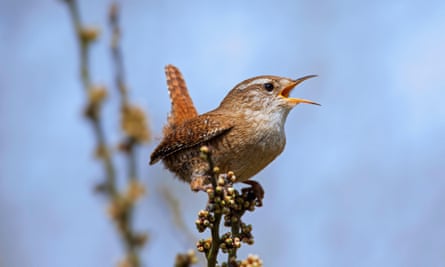
Wren (listen to its song here)
Tiny, brown and mouselike, with cocked tail. Bustles low down, too fast for the eye. A tuft of tumbleweed on the trellis. A perpetual motion meatball. Flight direct, whizzing, weightless, like a shuttlecock on a tiny motor. Sings repeatedly from cover, very loud, and tart, ending on a rapid trill.
As spring turns into summer and the fine weather persists, the park begins to fill with people once more, although most are still at pains to avoid each other. Squinting out on to the park lake, I see to my delight that the tufted ducks have given birth to 12 dark brown pom-poms: two per chick. In a few weeks they’ll have become more streamlined, but at the moment head and body seem to have only an accidental relationship. This makes for entertaining viewing – in their excited haste to dabble and snap at gnats, the top-heavy ducklings frequently overbalance and end up face-down in the water, before their madly scrambling legs and natural buoyancy set them right again. While her chicks are getting to know the water, the duck watches over them with the greatest vigilance. Her head and neck are in constant motion as she peers alternately at the sky and the shore.
Right at the end of July it’s reported that the sudden decline in human activity during the pandemic has been registered by seismologists as a wave of silence passing over the Earth, its course exactly following that of the virus. From China to Iran to Italy, vibrations from traffic, industry and construction work faded or, for a time, halted altogether; the crust of the planet ceased to judder with the noise that had been dinning, seemingly unstoppably, since the onset of the Industrial Revolution.
Finally, the Earth could hear itself think, and the voice of its thought was birdsong. A year on, we’re still too close to it to tell which stories and emotions will survive from that strangest of times. But it also seemed possible, even in the grimmest days, that the spring of 2020 might be remembered differently – as the time when we first heard the birds and, hearing them, began to recover an appreciation of something universal we had somehow mislaid.
Extracted from Birdsong in a Time of Silence by Steven Lovatt, published by Particular Books (£12.99). To order a copy go to guardianbookshop.com. Delivery charges may apply
